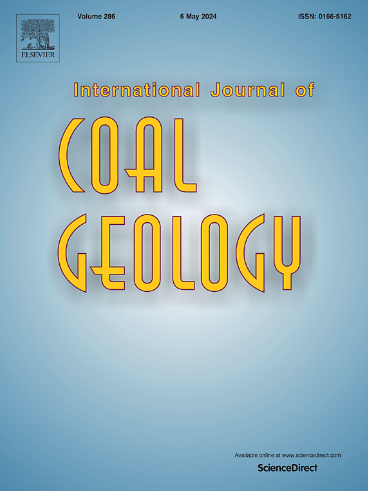与石炭纪晚期和二叠纪早期冰川期有关的古高原净初级生产力
IF 5.6
2区 工程技术
Q2 ENERGY & FUELS
引用次数: 0
摘要
泥炭地是一个重要的有机碳库,在全球碳循环中发挥着至关重要的作用。泥炭地的碳积累通过净初级生产力(NPP)反映出来,可对全球碳循环和气候变化产生影响。石炭纪晚期-二叠纪早期是冰室时期,位于低纬度地区的华北地块积累了大量厚煤层,为研究冰期和间冰期气候下的碳循环提供了机会。本研究对位于华北地块西部鄂尔多斯盆地的一个钻孔剖面中石炭纪晚期至二叠纪早期的本溪、太原和山西地层的天然伽马射线(GR)测井资料进行了光谱分析。发现了与天文轨道参数有关的周期信号,包括长偏心率(∼405 kyr)、短偏心率(∼125 kyr和∼95 kyr)和斜度(∼35.5 kyr)。利用长偏心率信号建立了浮动天文时间尺度,并进一步利用这一时间尺度来约束成煤古陆的堆积时间。太原地层 C8+9 煤层(厚 9 米)的古陆持续了约 203 千年,山西地层 C5 煤层(厚 4 米)的古陆持续了约 46 千年。根据这一时间范围和煤化过程中碳损失的估计,计算出石炭纪晚期-二叠纪早期低纬度泥炭地的碳积累率,C8+9煤层为104.7 ± 14.9 g-C-m-2-a-1,C5煤层为192.6 ± 11.6 g-C-m-2-a-1。根据碳积累率可以计算出古高原的净生产力(NPP),其中扣除了二氧化碳和甲烷流失造成的部分碳损失。计算得出的 C8+9 地层古高原平均净生产力为 199 ± 28 g-C-m-2-a-1,C5 地层为 366 ± 22 g-C-m-2-a-1。结合由北卡罗来纳州西部帕卢古断面的高精度 UPb 年代标定的绝对时间尺度,所调查地层的沉积时间被推定为 300.1 ± 0.5 Ma 至 294.3 ± 0.5 Ma。北加州盆地石炭纪晚期至二叠纪早期的煤层对应的冰期约为∼298 Ma。净生产力较低的泥炭地对应于气候变暖阶段,净生产力较高的泥炭地对应于气候变冷阶段。这意味着净生产力较低的古泥炭地往往碳储存效率较低,不能大幅减少大气中的二氧化碳。相反,古冰川地较高的净生产力往往会加速碳固定,导致气温下降和二叠纪早期间冰期的结束。本研究的结果可以揭示古冰川发育与同期古气候记录之间的关系,有助于预测未来气候变化。本文章由计算机程序翻译,如有差异,请以英文原文为准。
Net primary productivity of paleo-peatlands linked to deep-time glacial periods in the late Carboniferous and early Permian icehouse interval
Peatlands, an important organic carbon reservoir, play a crucial role in the global carbon cycle. The carbon accumulation of peatlands, reflected by net primary productivity (NPP), can have an impact on global carbon cycling and climate change. The late Carboniferous - early Permian is an icehouse period, during which numerous thick coal beds were accumulated in the North China Block (NCB) located within a low-latitude area, providing an opportunity for studying the carbon cycling under the glacial and interglacial climates. In this study, spectral analysis was performed on the natural gamma-ray (GR) logs of the Benxi, Taiyuan, and Shanxi formations of the late Carboniferous to early Permian in a borehole section located within the Ordos Basin in western NCB. Cyclic signals related to astronomical orbital parameters were identified, including long eccentricity (∼405 kyr), short eccentricity (∼125 kyr and ∼ 95 kyr), and obliquity (∼35.5 kyr). A floating astronomical time scale was established by using the long eccentricity signal, and this time scale was further used to constrain the durations of the accumulation of coal-forming paleo-peatlands. The paleo-peatland for the C8+9 coal seam (9 m thick) of the Taiyuan Formation lasted approximately 203 kyr, and the paleo-peatland for the C5 coal seam (4 m thick) of the Shanxi Formation lasted approximately 46 kyr. Using this timeframe and an estimation of carbon loss during coalification, the carbon accumulation rates of the late Carboniferous - early Permian low-latitude peatlands are calculated to be 104.7 ± 14.9 g·C·m−2·a−1for the C8+9 coal seam and 192.6 ± 11.6 g·C·m−2·a−1for the C5 coal seam. The NPP of the paleo-peatlands, which deducts a part of the carbon loss caused by the loss of CO2 and CH4, can be calculated from the carbon accumulation rates. The calculated average NPP of the paleo-peatlands for the C8+9 seam was 199 ± 28 g·C·m−2·a−1, and that of the C5 seam was 366 ± 22 g·C·m−2·a−1. In combination with the absolute time scale calibrated by high-precision U![]() Pb dates from Palougou section in western NCB, the depositional time of the investigated strata was constrained to be from 300.1 ± 0.5 Ma to 294.3 ± 0.5 Ma. The coal seams of the late Carboniferous to early Permian in the NCB correspond to an interglacial interval around ∼298 Ma. The peatland with a lower NPP corresponds to the warming stage and the peatland with a higher NPP corresponds to the cooling stage. This implies that a lower NPP of paleo-peatland tends to be less efficient in carbon storage, and could not reduce the atmospheric CO2 substantially. In contrast, a higher NPP of paleo-peatland tends to accelerate carbon fixation, leading to temperature decrease and the termination of interglacial interval in early Permian. The results of this study could provide insights into the relationship between the development of paleo-peatlands and the record of the paleoclimates during the same period, and could be helpful for the prediction of future climate change.
Pb dates from Palougou section in western NCB, the depositional time of the investigated strata was constrained to be from 300.1 ± 0.5 Ma to 294.3 ± 0.5 Ma. The coal seams of the late Carboniferous to early Permian in the NCB correspond to an interglacial interval around ∼298 Ma. The peatland with a lower NPP corresponds to the warming stage and the peatland with a higher NPP corresponds to the cooling stage. This implies that a lower NPP of paleo-peatland tends to be less efficient in carbon storage, and could not reduce the atmospheric CO2 substantially. In contrast, a higher NPP of paleo-peatland tends to accelerate carbon fixation, leading to temperature decrease and the termination of interglacial interval in early Permian. The results of this study could provide insights into the relationship between the development of paleo-peatlands and the record of the paleoclimates during the same period, and could be helpful for the prediction of future climate change.
求助全文
通过发布文献求助,成功后即可免费获取论文全文。
去求助
来源期刊

International Journal of Coal Geology
工程技术-地球科学综合
CiteScore
11.00
自引率
14.30%
发文量
145
审稿时长
38 days
期刊介绍:
The International Journal of Coal Geology deals with fundamental and applied aspects of the geology and petrology of coal, oil/gas source rocks and shale gas resources. The journal aims to advance the exploration, exploitation and utilization of these resources, and to stimulate environmental awareness as well as advancement of engineering for effective resource management.
 求助内容:
求助内容: 应助结果提醒方式:
应助结果提醒方式:


